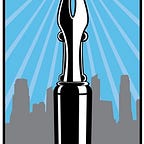Handheld Cameras and Losing Your Lunch at the Movies
I blame Woody Allen.
For me, the problem started with Allen’s Husbands and Wives (1992). As I watched the film in the theater, I was horrified to discover it was shot with handheld cameras. Excessive jerkiness! Shakiness! Swish pans!
I started to feel dizzy. Then I started to feel queasy. I had to leave the theater. I stood in the lobby just to give my eyes a rest.
When I returned to my seat, I had to close my eyes for long stretches at a time. I laughed aloud at Allen’s dialogue but was unable to watch the screen.
For me, the cinematography of Husbands and Wives renders it virtually unwatchable. Unfortunately, the film continued an insidious trend that has forced me not only to dampen my enthusiasm for going to the cinema, but also to be far more careful in the films I select.
I have few regrets in life, but one of my biggest is sitting through the full length of Saving Private Ryan (1998). With Husbands and Wives, I felt dizzy and nauseous for the rest of the evening. With Saving Private Ryan, I felt dizzy and nauseous the entire next day, even after a decent night of sleep.
I’m aware many filmmakers think handheld camerawork makes their art more realistic. But I’d argue it makes the film more artless, especially if used heavily throughout.
I suffered in relative silence about all of this until I had an opportunity to speak up.
In 2010, an issue of the LA Times carried the following opinion about Kathryn Bigelow’s war film The Hurt Locker:
I’m sorry, what is up with you people? Despite heaps of praise, too many of you are taking a pass. Are you worried that it’s just another desert war movie, depressing story, faces hidden by burkas or beards? Well, let’s defuse that notion. What we have here is a psychological thriller, man against machine, the clock ticking as Jeremy Renner, a stealth bomb of an actor, sets about disarming the homemade kind. It’s chess reconceived as an extreme sport, every action carrying the possibility of reaction. […] Aren’t you a little curious? — Betsy Sharkey, February 25, 2010
The following week, I responded to Ms. Sharkey in the LA Times, saying that despite the critics’ (and her) heaps of praise, I would still be taking a pass on The Hurt Locker.
I further explained my reason had nothing to do with the content of the film or its quality. Rather, I wouldn’t be seeing The Hurt Locker for the same reason I would not be watching Precious, Breaking the Waves, The Blair Witch Project, Moulin Rouge, or Cloverfield.
It’s the same reason I walked out of The Bourne Supremacy after 15 minutes and Traffic after 5.
Handheld cinematography makes me wobbly and sick, and I’m not alone — as the infamous “Cloverfield illness” suggests. See also this post on “losing it at the movies” and this one and this.
I concluded my response to Ms. Sharkey, “I love watching movies, but if a trailer or a promoted film clip features handheld cinematography, I’m out.”
The use of handheld cinematography continues, of course. I refused to see Argo in a theater because I could tell from the trailer it contained several segments filmed with a handheld camera.
Later, I rented Argo via Apple TV. I enjoyed the film, and I’m happy I saw it — in my home. On a small screen, with my living room wall in the background to give my eyes a reference point, Argo’s cinematography was annoying but never made me feel dizzy as it would’ve projected onto a 30-foot screen.
Now, when I want to watch a story unfold, I go where handheld camerawork is not. Or I go where I am my own cinematographer, choosing for myself what to look at and for how long: I go to the theater and watch a play.
